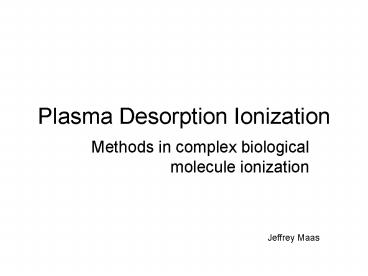Plasma Desorption Ionization - PowerPoint PPT Presentation
1 / 11
Title:
Plasma Desorption Ionization
Description:
Four methods for ionization of large molecules ... 4) H.D. Beckey, A. Heindrichs, H.U. Winkler. Int. J. Mass Spectrom. Ion Phys. 3, 9 (1970) ... – PowerPoint PPT presentation
Number of Views:802
Avg rating:3.0/5.0
Title: Plasma Desorption Ionization
1
Plasma Desorption Ionization
- Methods in complex biological molecule ionization
Jeffrey Maas
2
Complex Bio-molecules
- Mass Spectrometry is limited, because it
requires volatilization of the sample. - Problem
- Low vapor pressure leads to few ions for
detection. - Solution
- Heating sample increases vapor pressure.
- Opposition
- Heating sample also increases decomposition.
3
History
- Four methods for ionization of large molecules
- Increase sensitivity for low vapor pressure
McIver - New instrument (ICR)
- Chemical alteration of polar groups to non-polar
substituents Watson - Additional complicated steps
- Deposit analyte on a non-reacting surface to
increase vapor - pressure Buehler
- Only verifed for a small group of peptides
- Heating in the presence of a strong electric
field reduces heat of vaporization Beckey - High decomposition of molecules
- Observed Phenomena leading to PDMS
- Vaporization rate gt Decomposition rate(T gt 400K)
- Buehler - Heating at fast rates lowers decomposition -
Torgerson
4
PDMS spontaneous fission of 252Cf
- Ionization of large bio-molecules achieved by
PDMS - Ions heavier than Kr with energy gt 100MeV can
penetrate films up to 10µm thick - 252Cf fission most often produces the pair
- 142Ba18 at 79MeV
- 106Tc22 at 106MeV
- 252Cf can heat the sample locally up to 10,000ºK
- Rapid heating occurs on a time scale in which
most of the energy is not coupled into
vibrational motion. - Deposits 10MeV through Coulomb interaction in
10-13s corresponding to 16 watts/fission fragment
or 10 terawatts/cm2!
5
PDMS
- Process using PDMS
- Sample is deposited over a 1cm2 region on Ni foil
1µm thick - Foil is aligned with 252Cf source for maximum
energy transfer - Two fission fragments occur from the 252Cf
- First travels towards a start detector
- Second travels into the Mass Spectrometer
- Ionization occurs through ion-pair formation
- An electric lens accelerates the ions into the
TOF - Standard TOF analysis at this point
6
Details of the Process
Ions in the Plasma
Fission Fragments
(Which would be mounted on a thin foil)
Californium-252 Plasma Desorption Mass
Spectroscopy R. D. Macfarlane D. F. Torgerson,
Science, New Series, Vol. 191, No. 4230. (Mar. 5,
1976), pp. 920-925. Figure 2
7
Details of the Process
- Time of flight set up with PDMS
(Used for ion orbit)
Californium-252 Plasma Desorption Mass
Spectroscopy R. D. Macfarlane D. F. Torgerson,
Science, New Series, Vol. 191, No. 4230. (Mar. 5,
1976), pp. 920-925. Figure 1
8
Unique Timing Aspects of PDMS
- Typically used with TOF MS due to the creation of
fission fragment pairs - Two fragments give timing ability with precision
of 10-9s - Continuous operation
- for trace detection
PDMS. (2006, June 21). In Mass Spectrometry Wiki.
Retrieved 9am, September 26, 2007, from
http//mass-spec.lsu.edu/mswiki/index.php/Plasma_d
esorption_mass_spectrometry
9
Results of PDMS
- Positive and negative ions produced in equal
amounts for further determination - Low fragmentation of parent ion
- Ability to detect trace amounts by continuous
operation - Each event at the detector can be calibrated to
the sister ion produced at the point of fission - PDMS was short lived due to the realization of
MALDI which improved upon the concepts described
here.
10
Remember
- PDMS generates a plasma by striking a thin Ni
foil with a sample deposited on it and
subsequently breaking the dimer. - PDMS is used with TOF because it has a unique
timing feature. - PDMS can be used with other applications due to
the low energy ions created. - PDMS in this configuration uses a radioactive
source for nuclear fission fragment emission. - PDMS can be observed by any means of bombarding a
sample with high energy ions. It is the
combination of a rapid thermal desorber, with a
little energy left over for ionization.
11
References
- 1) R. T. McIver, E. B. Ledford. Jr., J. S.
Miller. - Anal.Chem. 47, 692 (1974).
- 2) J. T. Watson and K. Biemann,
- ibid. 37, 844 (1965).
- 3) R. J. Beuhler, E. Flanigan, L. J. Greene, L.
Friedman. - J. Am. Chem. Soc. 96, 3990 (1974)
- 4) H.D. Beckey, A. Heindrichs, H.U. Winkler.
- Int. J. Mass Spectrom. Ion Phys. 3, 9 (1970)
- 5) D.F. Torgerson, R.P. Skowronski, R.D.
Macfarlane. - Biochem. Biophys. Res. Commun. 60, 616 (1974)






























